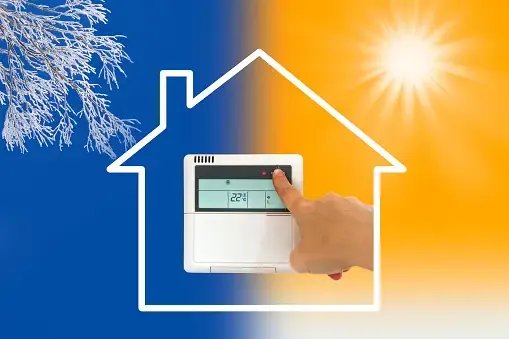
Understanding Smart Thermostats
Smart thermostats represent a significant advancement in the realm of home energy management. Unlike traditional thermostats, which require manual adjustments for temperature changes, smart thermostats offer automated functionalities designed to enhance both comfort and energy efficiency. These devices utilize Wi-Fi connectivity to allow users to control their home’s heating and cooling systems remotely through smartphones, tablets, or computers.
One of the fundamental features of smart thermostats is their compatibility with various smart home systems. This allows them to integrate seamlessly with other devices, such as smart speakers, security systems, and lighting controls. This integration creates a cohesive ecosystem that can lead to a more efficient home while providing users with added convenience. For instance, when the security system is armed, the smart thermostat can automatically lower or raise the temperature, enhancing both comfort and energy savings.
Another innovative characteristic of these devices is their learning algorithms. Over time, smart thermostats analyze user behavior and preferences to create customized heating and cooling schedules. This adaptive technology means that the thermostat can optimize energy usage by adjusting settings based on when dwellers are home, away, or asleep. As a result, energy bills can be significantly lowered without sacrificing comfort.
Furthermore, the remote access feature enables users to monitor and adjust temperatures from virtually anywhere. This not only grants the ability to make immediate changes when plans shift but also allows for the management of energy consumption during periods of absence. Overall, smart thermostats serve as essential components in modern homes, contributing to energy efficiency and fostering greater control over indoor climates.
How Smart Thermostats Help Reduce Energy Consumption
Smart thermostats are revolutionizing the way we manage climate control in our homes and offices, leading to notable reductions in energy consumption and, consequently, lower energy bills. One of the key features of these advanced devices is their scheduling options, which allow users to set specific temperatures for different times of the day. By programming the thermostat to lower the temperature at night or during work hours, homeowners can significantly reduce unnecessary heating and cooling, thus saving on energy use.
Another innovative capability of smart thermostats is geofencing. This technology utilizes the GPS functionality of smartphones to detect when occupants are leaving or returning to their home. When users exit a predetermined area, the thermostat can automatically adjust to an energy-saving mode. Conversely, when users return, the device can ensure that the environment is comfortable by pre-heating or pre-cooling the space. This seamless adjustment minimizes energy waste, especially compared to traditional thermostats that may continue to run at consistent settings regardless of occupancy.
Adaptive learning is yet another feature that distinguishes smart thermostats from conventional ones. These devices analyze user behavior over time, learning individual preferences and environmental patterns. This capacity for optimization means that the thermostat can efficiently adjust settings for maximum comfort while also being energy-conscious. For instance, a study conducted by Nest Labs reported that users could save an average of 10-12% on heating and 15% on cooling costs annually, thanks to the adaptive learning functionalities embedded within smart thermostat technology.
In practical terms, these energy-efficient strategies not only contribute to significant savings on utility bills but also promote a more sustainable lifestyle by reducing overall energy consumption. By integrating smart thermostats into daily life, individuals and businesses alike can be part of the solution to energy conservation.
Choosing the Right Smart Thermostat for Your Home
When selecting a smart thermostat, it is essential to consider various factors to ensure compatibility with your home’s heating and cooling systems. The first step is to assess whether your existing HVAC system is compatible with smart thermostats, as some models may not support certain configurations. This information can typically be found in the user manual or by consulting with a professional technician.
Next, it is crucial to set a budget for your smart thermostat purchase. Prices can vary significantly based on features and brand reputation. While it may be tempting to choose the most feature-rich model, it is important to weigh the benefits against the cost. Consider what features are necessary. Some common functionalities include remote access via smartphone apps, learning capabilities, and energy usage reports, which can assist in optimizing your energy consumption.
Installation ease should also be evaluated. Some smart thermostats are designed for straightforward DIY installation, while others might require professional assistance. A model that is easy to install can save you both time and additional costs. Determine whether the model you are considering provides detailed installation instructions or video tutorials to aid the process.
To assist in making an informed decision, a comparison of popular models such as Nest Learning Thermostat, Ecobee SmartThermostat, and Honeywell Home T9 can be useful. The Nest Learning Thermostat offers advanced learning capabilities, while Ecobee features include room sensors to manage different areas of your home efficiently. Conversely, Honeywell’s T9 is known for its affordability and straightforward interface. Each model comes with its own pros and cons, which should align with your home’s specific needs and preferences.
Tips for Maximizing Energy Savings with Smart Thermostats
Smart thermostats have revolutionized home energy management, providing users with various features designed to enhance energy efficiency. To achieve maximum savings, it is essential to implement specific strategies that capitalize on these advanced functionalities. One fundamental practice is to establish a customized heating and cooling schedule tailored to your lifestyle. By programming the thermostat to lower temperatures during inactive hours or when residents are away, users can significantly reduce energy consumption.
Furthermore, many smart thermostats come equipped with learning algorithms that adapt to your routine. Allow the device some time to gather data on your habits, enabling it to make automatic adjustments. This capability not only optimizes heating and cooling but also maintains comfort without requiring constant manual adjustments. In addition, users should explore integrations with other smart home devices, such as occupancy sensors or smart lighting systems. By configuring these devices to work in conjunction with the smart thermostat, individuals can create a cohesive energy-efficient environment, minimizing energy wasted during unnecessary heating or cooling.
Continuous monitoring of energy usage is also paramount. Most smart thermostats offer insights into energy consumption patterns, allowing homeowners to identify areas for improvement. Review these reports regularly to make informed adjustments to your heating and cooling settings. Lastly, routine maintenance and updates cannot be overlooked. Regularly check for firmware updates, as manufacturers often release enhancements that improve functionality and efficiency. Additionally, ensure that the thermostat is properly calibrated and that any connected HVAC systems are well-maintained. By following these tips and leveraging the full potential of smart thermostats, users can effectively lower their energy bills while contributing to a more sustainable future.

